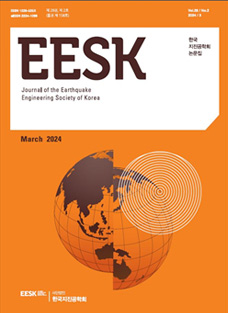1.Introduction
A response spectrum is mostly made performing seismic analyses of a single degree of freedom(SDOF) system, which is convenient and efficient to predict dynamic effects on the various structural systems having a short fundamental period and governing the dynamic behavior of a system by a first mode. However, a response of a tall building which has a long fundamental period might be affected by higher modes of a system resulting a beneficial or detrimental effect on the system. Soil layers beneath the foundation of a building also could affect on the response spectra due to structure-soil interactions including kinematic and inertia ones. Soft soil layer would be beneficial on the response of a building in the short period range, but it might be harmful in the long period range.
Studies on the high-rise building system were performed for various topics by many researchers during several decades. Some studies on the seismic responses of a high-rise building were related to dynamic analysis, vertical mass irregularity, higher mode uncertainty, story-drift, shear and overturning moment estimation, and soil type effect.
Seismic behavior of high-rise steel frames was investigated considering vertical mass irregularity by Choi and Song[1] in 2004, and Control of earthquake responses of buildings were studied taking into account higher mode uncertainty by Koh et al.[2] in 2000. Story shear forces considering high modes were studied through a pseudo dynamic analysis by Lee et al.[3] in 2001, and seismic force distribution on multistory building structures was also examined by Jun et al.[4] in 1994. Shear force and overturning moment of a building were estimated from building seismic records constructing mode shapes by Mau and Aruna[5] in 1994. Seismic responses of tubular structures for different soil types were studied by Chon et al.[6] in 2007, and horizontal seismic responses of buildings built on a soft soil layer were also examined by Kim[7] in 2001.
However, a research on the effect of high modes to the seismic responses of a high-rise building having a foundation on a soft soil layer was not able to search in the data base of domestic and foreign journals.
vIn this study, seismic responses of a building was investigated by modelling a building as a multi-degree of freedom(MDOF) system and comparing response spectra of a SDOF system with those of a MDOF system. Response spectra were also compared considering 3 different underlying soil types of SB, SC and SD. Seismic response analyses of a structure-foundation-soil system were carried out utilizing a pseudo 3D finite element program of P3DASS with seven bedrock earthquakes downloaded from the PEER database.
2.Model of a Structure-Foundation-Soil System
A finite-element software for Pseudo 3-Dimensional Dynamic Analysis of Structure-Soil System (P3DASS) utilized in this study was developed to perform the horizontal seismic analysis of a structure built on a surface or embedded foundation in a linear or nonlinear soil by Kim[8-9] using the cylindrical coordination system. P3DASS can solve for multiple seismic responses of a SDOF building system built on layered soil in a single run. The soil around a foundation is assumed to be layered on bedrock or relatively stiffer soil as shown in Fig. 1. The soil layer can be divided into sub-layers for the finite-element analysis, and partitioned into a cylindrical core region under the equivalent circular foundation and the far field outside of the core. An arbitrary shaped foundation can be modeled as an equivalent circular foundation having the same area or moment of inertia (aspect ratio up to 4 is acceptable for a rectangular shaped foundation; Roesset[10]). The validity of an equivalent circular foundation in the seismic analysis was verified in references of Kausel[11], Roesset[10], Gazetas and Tassoulas[12], and Kim[8]. A mat foundation and the soil under the foundation in the core region are subdivided into toroidal finite-elements considering the horizontal and vertical displacements around the circumference of a cylinder. The far field is represented by the consistent transmitting boundary matrix developed by Kausel[11] reproducing an extension of the finite-element mesh from the foundation boundary to infinity. The consistent transmitting boundary can be placed at the edge of a circular foundation for the linear elastic analysis according to Kim and Roesset[9].
In this study, the 30m thick (H) soil layer lying on stiff bedrock was considered assuming that it is horizontally layered, homogeneous, elastic, viscous and isotropic. Five shear wave velocities of 100, 180, 360, 760 and 1500 m/s for the soil were considered to classify the site for the seismic analyses. They are the boundary shear wave velocities specified in IBC2009[13] to classify the site classes. Unit weights of the soil were assumed to be 16, 16, 18, 20 and 26 kN/m 3 depending on the shear wave velocities respectively, and Poisson's ratio of 0.3 and initial damping ratio of 0.05 were also assumed. Furthermore, the foundation was taken as a rigid cylindrical mat foundation with an embedment, while the unit weight of a mat foundation embedded less than 3.3 m was set equal to 23.5 kN/m 3 without a basement and, otherwise, 3.56 kN/m 3 considering the basements of a building. For a surface foundation with a zero embedment, it was assumed to be embedded 1m for the practical purpose. The seismic design response spectrum of a SDOF system was developed assuming the damping ratio of 0.05.
For the seismic analyses, seven records shown in Table 1 were selected among the seismic records provided by the Pacific Earthquake Engineering Research Center (PEER)[14] in Berkeley. They were recorded at rock sites (site class B) having shear-wave velocity of greater than 750 m/s defined by United States Geology Survey (USGS) or at the site estimated as A (rock) by the Geomatrix site classification system. Peak accelerations of the records were scaled to be 0.117 g for the study, and corresponding response spectra are plotted in Fig. 2. However, these seismic records were recorded at the outcrop corresponding to the site class B in IBC2009, and it is necessary to generate seismic records at the bedrock located at 30 m below the outcrop by the de-convolution process assuming that the shear wave velocity of the site class B is 1050 m/s for the rational seismic analysis of the structure-soil system as discussed by Roesset and Kim[8].
Seismic analyses of a structure-soil system were carried out in the frequency domain from 0 to 30 Hz for the structures having the fundamental periods between 0 and 3 seconds with the period interval of 0.1 second.
3.Comparison of Elastic Responses of SDOF and MDOF systems
Elastic responses of a SDOF system were compared with those of a MDOF system to examine the effects of a MDOF system as shown in Fig. 3. A building was assumed to be built on the soil layers of SB, SC and SD having shear wave velocities of 1050, 624 nd 274 m/s.
For a SDOF system, the mass was assumed to be 75% of the total mass of a building, and the stiffness of a system was calculated assuming a fundamental period of 0.1 times the number of stories of a building. Also stiffnesses of a MDOF system (km) shown in Fig. 4 were back-calculated as a function of a story mass (M) to have a fundamental period of 0.1 times the number of stories of a building, and the curve fitted equations(km =alpha*M) are given in Eq. (1)to utilize in the seismic analyses as follows.
Homogeneous soil layers of SB, SC and SD with a 30m depth were assumed to have unit weights of 23, 20 and 18 kN/m 3 and Poisson’s ratios of 0.3, 0.35 and 0.4. A surface foundation having a nominal embedment of 0.5m was assumed for the practical purpose of a study.
In Fig. 3, averaged responses of SDOF and MDOF systems are shown, which are the results of 7 bedrock earthquakes of 0.075g. Peak responses of a MDOF system in the short period range shown in Fig. 3(a) are approximately 6%, 4% and 10% smaller than those of a SDOF system for the soil layers of SB, SC and SD respectively indicating allowable differences. However, responses of a MDOF system in the long period range from 1Hz to 3Hz shown in Fig. 3(b) are 1.48, 2.5 and 2.12 times larger than those of a SDOF system for the soil layers of SB, SC and SD respectively showing approximately 2 times lager responses.
4.Comparison of Response Spectra of SDOF and MDOF systems
Averaged elastic response spectra of a MDOF system were compared with those of a SDOF system built on a surface foundation lying on three soil types of SB, SC and SD in Fig. 5. Maximum responses of a MDOF system are approximately 5%, 5.3% and 7.8% smaller than those of SDOF system for three soil types in the short period range. However, responses of a MDOF system are approximately two times larger than those of SDOF system in the long period range. Those results indicate that seismic analyses of a high-rise building as a SDOF system may lead to an unsafe structural design.
Responses of a MDOF system were also compared with design spectra of KBC2009[15] in Fig. 6. Responses of a MDOF system were 33% and 28% smaller than those of KBC for SB and SD soil layers, but 35% larger for a SC soil layer in the short period range. In the long period range, however those were 76%, 76% and 80% smaller than those of KBC for SB, SC and SD soil layers, indicating that design spectra of KBC is too conservative (approximately 4-5 times) for tall buildings.
5.Comparison of Base Shear Forces and Moments of SDOF and MDOF systems
Base shear forces of a MDOF system were compared with those of a SDOF system to investigate the effect of a MDOF system as shown in Fig.7(a). Basic shapes of base shear force spectra of a MDOF system are similar to those of a SDOF system. However, peak values of the shear force with a MDOF system are approximately 28% larger than those of a SDOF system in the short period range, and average shear forces with a MDOF system in the long period range are 2 times larger for SB soil layer and 3 times larger for SC and SD soil layers. It also can be seen that base shear forces in the long period range are reduced gradually with a higher fundamental period, and base shear forces with SC and SD soil layers are almost identical indicating a limited effect of soft soil layer.
Base overturning moments of a MDOF system were also compared with those of a SDOF system as shown in Fig.7(b). Basic shapes of base moment spectra of a MDOF system are similar to those of a SDOF system. But peak base moments of a MDOF system in the short period range are 29%, 36% and 19% larger than those of a SDOF system for SB, SC and SD soil layers respectively, and average overturning moments at the base of a MDOF system are 16%, 13% and 16% larger in the long period range. The effects of a MDOF system and a soft soil layer on the base moment are more prominent in the short period range than in the long period range.
The effect of a MDOF system is more significant on the base shear force than on the base moment, and a high-rise building has more significant effect on the base forces maintaining almost constnt values in the long period range. A soft soil layer also has some effect on the base shear force of a high-rise building converging to a limited value independently on the soft soil type, and has more prominent effect on the base moment.
6.Comparison of Story Shear and Story Moment of MDOF system
Story shear forces at a maximum base shear force are plotted for 6 buildings of 5, 10, 15, 20, 25 and 30 stories having fundamental periods of 0.5, 1.0, 1.5, 2.0, 2.5 and 3.0 seconds in Fig. 8(a). The shape of story shear forces seems to be the 1 st mode for a short building, but seems to be the 2 nd , 3 rd or 4 th mode for a tall building showing a little difference in a base shear force of a taller building.
Story base moments at a maximum base moment are also plotted for 6 buildings in Fig. 9(b). The shape of story moment also seems to be the 1 st mode for a short building, however seems to be the 2 nd , 3 rd or 4 th mode for a tall building, showing a maximum story moment at a top part and a gradual decrease in a base moment of a taller building.
Study results on story base shear force and story moment indicate that higher modes of a MDOF system contribute to a reduction of base shear force and base moment making them almost the same, and show that maximum shear force and maximum base moment does not occur simultaneously as shown in Fig. 8 and Fig. 9.
7.Conclusions
Response spectra of high-rise buildings built on soft soil layers were studied to examine the effects of higher modes on the dynamic response of a tall building by comparing them with those of a SDOF system. Study was performed utilizing a pseudo 3D finite element program of P3DASS with seven bedrock earthquake records downloaded from the PEER database. Effects of higher modes on the response of a tall building were studied for base shear force and base moment of a MDOF system including story shear forces and story moments.
Study results show that the response of a MDOF system is a little bit smaller and more conservative than that of a SDOF system in the short period range, but is approximately 2 times larger in the long period range. However, the response of a MDOF system in the long period range is much smaller (almost 1/4-1/5) than that of KBC design spectrum for all types of soil layers suggesting more affirmative results.
Higher modes of a MDOF system contribute to a reduction of base shear force and moment. Base shear force and moment are peaked at the base with a short period building (approximately up to 0.5sec), but they are reduced to approximately constant values with longer period buildings. The effect of a MDOF system is more significant on the base shear force than on the base moment. Maximum story shear force and moment occurred at the top part of a building rather than at a base in the cases of tall buildings differently from short buildings, and higher modes of a tall building affected significantly on the base forces making them almost the same at the base.
On the other hand, a soft soil layer has some effect on the base shear force of a high-rise building even though the soft soil characteristics are not so important, and it also has a prominent effect on the base moment.





















